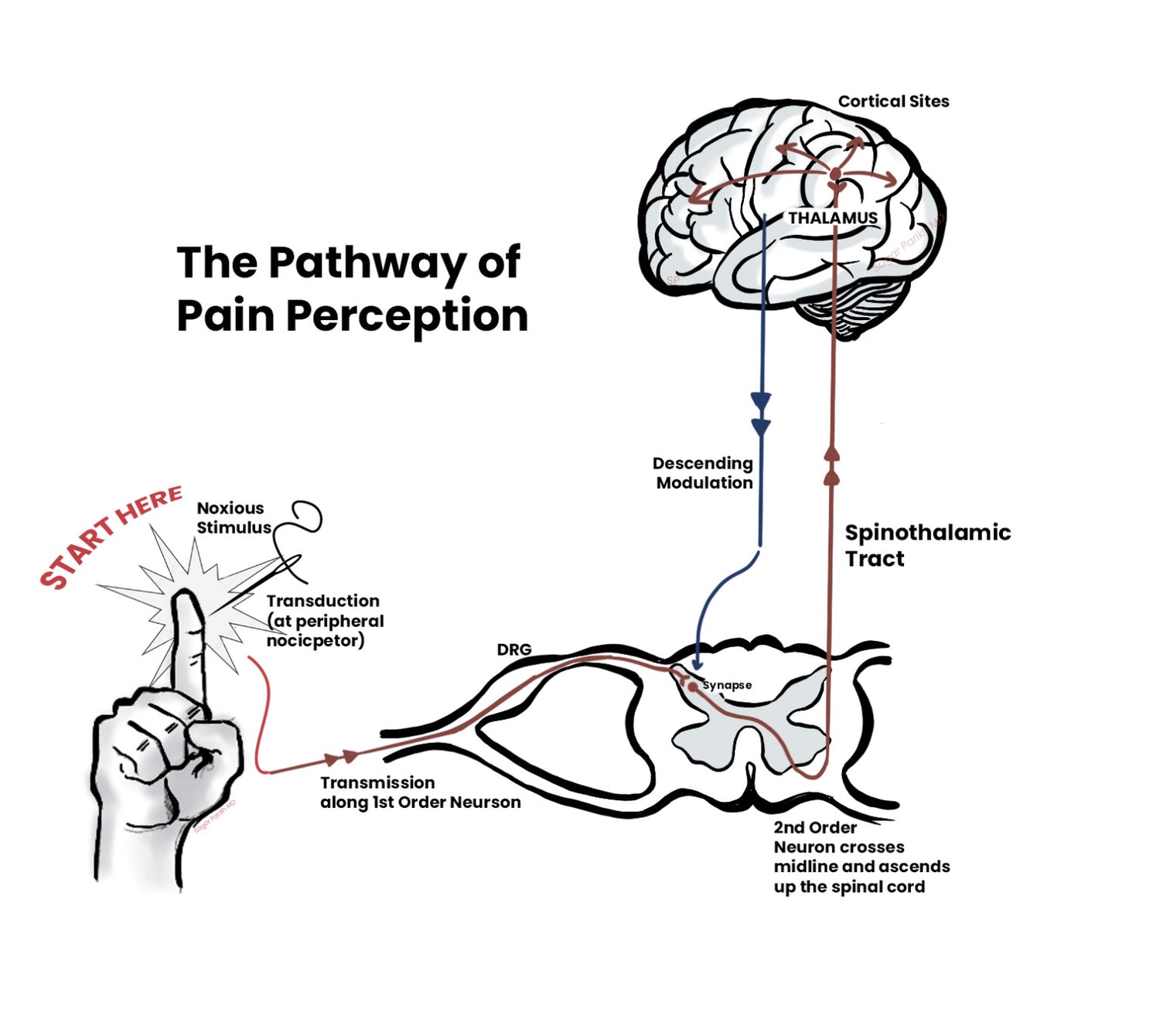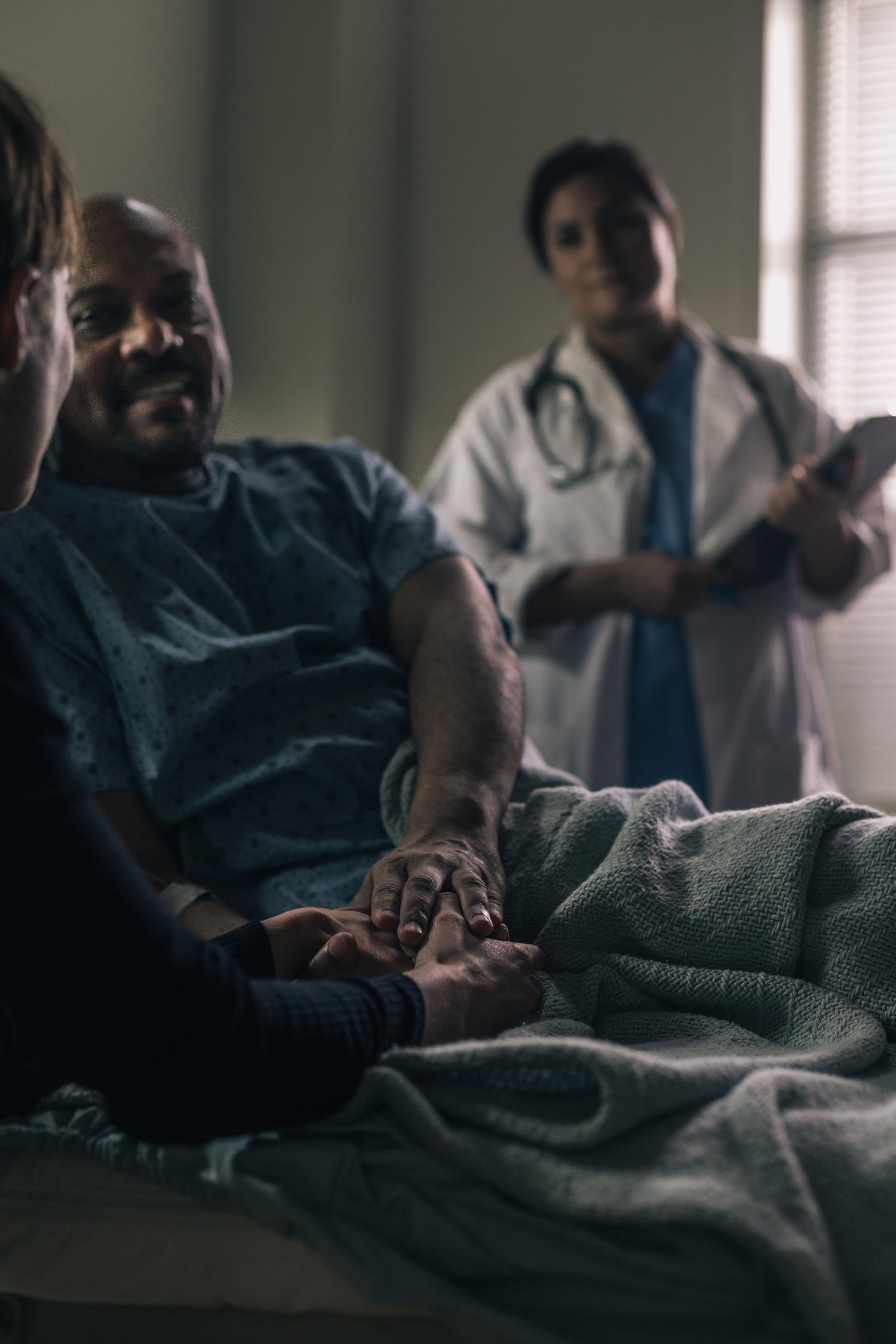For people who live in chronic pain and have adapted their lifestyles to return to homeostasis and still experience chronic pain, pain procedures are a fantastic tool to increase their quality of life, mobility and health.
Pain procedures do not carry the risk of surgery and they do not, unlike surgery, damage the underlying tissue of your body.
WHAT ARE PAIN PROCEDURES?
A pain procedure (block, pain block, neuromodulation) is a medical procedure performed by a doctor in a sterile setting using X-rays or sonar guidance.
During the procedure, a part of the nervous system is blocked from sending pain signals to the brain.
WHEN ARE THEY PERFORMED?
Pain procedures are used to treat nociceptive or neuropathic pain (link to types of pain page), or in some cases to control pain when treating the underlying disease does not take away the pain.
Some of the common conditions that pain procedures are used for are:
Spinal conditions (back pain, neck pain and headaches secondary to spinal osteoarthritis, and disc disease).
Neuropathies
Cancer pain
Post traumatic conditions
Facial pain syndromes
Pelvic pain syndromes

HOW DO PAIN PROCEDURES TREAT PAIN?
Pain procedures reduce and interrupt the signals coming from irritated nerves. This is a bit like putting ear-plugs in to block your neighbour’s loud music! If there are less signals reaching the brain, or the signal is interrupted completely, the brain pays less attention and turns the volume down on your pain!
Disruption and neuromodulation are the two main ways of stopping the signal from the nerve reaching the brain.
Disruption: One can cut through a peripheral nerve using surgical instruments or you burn or freeze a peripheral nerve to disrupt(stop) the flow of signals.
Neuromodulation: The safer alternative is to use pulsed radio frequency modulation which just changes the way the nerve relays information so that the brain no longer receives the same pain signal.
At the PAIN COLLECTIVE we prefer to use neuromodulation and a variety of blocks with medication as our procedures of choice.

WHAT ARE THE ACTUAL STEPS IN PERFORMING A PAIN PROCEDURE?
Pain procedures are performed under conscious sedation, administered by a sedationist in a sterile environment.
A fluoroscopy machine (X-ray machine) is sometimes used to view the areas of the body where the procedure is performed and sometimes ultrasound (sonar) guidance is used.
Your doctor will, under sterile conditions, target and place specifically designed needles at the area where the modulation is to be performed. This is frequently the spine, as this is where most nerves enter the central nervous system, and they can easily be blocked here.
Pulsed radio-frequency waves are delivered through a radio-frequency generator, and are conducted into the needles by small electrodes. It is these waves that cause the neuromodulation effect.
Are these procedures safe?
If the doctor is adequately trained and experienced and follows the correct protocols, these are some of the safest medical procedures known.
Is the treatment permanent?
Any treatment aimed at peripheral nerves (nerves outside the spinal cord or brain) is likely to be temporary. Peripheral nerves send signals to the brain from the body, and when damaged, they can and will regenerate. For instance, if you have an operation, the skin next to the scar may feel numb for a few weeks or months, as nerves were cut through when the surgeon cut through your skin. They take some time to grow back together, but eventually the sensation becomes normal again.
Your grandmother who had a stroke, however, may not fully recover. This is because the nerves of the central nervous system (spinal cord and brain) do not have the same capacity to recover as the peripheral nerves.
The important thing to remember is the following: you cannot stop peripheral nerves from sending messages permanently, they always recover. Even if you cut through them, they grow back.
So, if the response is temporary, for how long do these procedures work?
Neuromodulation procedures relieve pain on average for about 18 months to 24 months. In some people, it may only reduce pain for a few months, however. The effect of the procedure is heavily influenced by how healthy your body is to begin with. If the underlying disease that is causing the inflammation that is causing the pain, is not well-controlled, then the procedure may not be as effective as it could be – this is why making changes to your diet, your level of physical activity and your mental well-being is so important!
How well do these procedures work?
When performed by a skilled doctor, for the right reasons, in patient who takes responsibility for managing the underlying disease, these procedures work extremely well.
I am told that my medical funder (medical aid) has specific protocols?
Each funder does indeed have different rules and protocols for pain procedures and
sometimes within different plans of the same medical aid, there are different rules. The PAIN COLLECTIVE has an authorisation team that remains on the cutting edge and engages with the funders on your behalf.
Our team will work with your funders and with you to follow the protocols, so that your
funder will cover the cost.
How should I prepare for the procedure?
Your doctor will ensure that all the relevant medical checks have been performed on you to prepare you for your procedure. The administration team will have arranged all
your authorisations and paperwork. You will receive your booking confirmation by email, or WhatsApp and our team will call you to confirm and details that you are unsure about.
You will be informed if and when you need to stop any medication in the days leading up to your procedure. Instructions about when you should stop eating and drinking before
your procedure will also be provided.
Costs
The PAIN COLLECTIVE contracts with your medical aid for their agreed rates.
What should I expect after the procedure?
It is important that you follow the exact instructions of your team. There are important visits scheduled with your team following your procedure. During these visits your doctor will monitor your progress, you will undergo your pain science education, you will receive information and guidance about the necessary dietary adaptations required for your disease and your movement maintenance programs will be set up.
Your journey towards less pain and better quality of life follows a few simple patterns
and rules and being aware of these is important in having the right expectation of your procedure and will lead to greater satisfaction and better outcomes.
Rules and Patterns
You already know that the perception of pain, in people who live in chronic pain, is not directly related to the severity of the underlying disease, is sometimes felt distant to the site of the problem and that the sensation is sometimes false, and that is important to understand what to expect following a pain procedure.
Please see the section ‘WHAT IS PAIN’ you have not yet read it.
Patterns
Following a pain procedure, the following patterns are observed:
If only a local anaesthetic drug is used, then the relief is immediate and lasts typically for
a day or two. If a steroid is added to the local anaesthetic injection, the relief typically lasts for a few weeks, on average about three weeks.
If a pulsed radio-frequency neuromodulation was performed, the relief starts slowly from
about the six to ten weeks mark and typically lasts for an average of 18 months with a span of six to 24 months.
Rules
The following rules are important:
Patchy pain relief.
All the pain does not go away immediately. You may experience patchy pain relief for a long period of time – this is normal.
There is a ‘window’
At the three week mark, or sometimes before this or sometimes after this period, there will be a period where your pain may return, and sometimes have greater intensity than before. We refer to this as the ‘chemical electrical window’ or just the ‘window’ for short. This is because the chemical effect of the medication that was injected stops working before the electrical effect of the pulsed radio-frequency neuromodulation can kick in. This happens to most people who
have pulsed radio-frequency neuromodulation.
What you are feeling may be false.
Your brain struggles to understand the garbled messages from the nerves that are busy shutting down following a pulsed radio frequency neuromodulation. This means that you may have patches of funny sensation or even pain in areas that you did not have before. It is important to discuss these symptoms with your doctor and therapists in the period following your procedure so that they may reassure and counsel you when there is nothing to worry about and to investigate any symptoms that cause concern. These ‘ghost’ symptoms will disappear as the effect of your pulsed radio frequency neuromodulation kicks in and your pain abates.
Visits
There are a few appointments that you will have to keep in the three months following your pain procedure and these appointments will determine your short- and log-term outcome. There are two main reasons that the follow-up appointments are crucial.
Education
The education you require to be the leader of your team for your own disease requires that you are taught about pain, diet, movement and self-management. We work within carefully controlled clinical care pathways based on clinical care protocols
informed by both anecdotal experience, and
published and unpublished data.
This means that based on all the science available to us, we have developed a trusted recipe that works really well, but we need you to be an active partner in executing
the plan. The visits equip you with the tools required to look after yourself.
This means that based on all the science available to us, we have developed a trusted recipe that works really well, but we need you to be an active partner in executing the plan. The visits equip you with the tools required to look after yourself. Not attending your appointments is like only adding half the ingredients to a recipe – it’s bound to be a flop!
Monitoring your outcome
Your doctor and the rest of your team must follow your progress and make sure you are improving as expected. Any concerns either from you, your friends and family, or your healthcare team must be addressed in these visits.
Symptoms
Most people who have a pulsed radio-frequency neuromodulation procedure will have minimal to no symptoms at the 12 week visit and can be discharged into maintenance. Prior to that the symptom-relief will be patchy, but progressive. Some people with a lot of inflammation or very advanced disease may even take longer than 12 weeks to have pain-relief.
If you are concerned, speak to a member of the interdisciplinary team.
I am concerned, what should I do?
The clinics of the PAIN COLLECTIVE are chronic pain clinics and are only open during office hours. If you are experiencing pain that concerns you, contact us so that we may attend to you and advise the best way forward. After hours or weekends, please attend your nearest emergency care provider. This may be a clinic, your primary care physician, an emergency room or a therapist.
What does it mean to be discharged into maintenance?
This means that you are now ready to control the aspects of movement, nutrition and self-management of your chronic underlying disease yourself, and that your symptoms have been managed effectively. You will be responsible for your own health and well being by virtue of your actions going forward – but the team is just a phone call away.
Now that you do not have pain anymore, can you relax and go back to your old ways?
If you have less pain because of a successful pain procedure, you still have an underlying
disease that requires management. If you do not look after the underlying condition, your disease will progress, your pain procedures will not work as well as they could, your relief will be shorter and future procedures may
eventually be completely ineffective. The underlying disease will lead to reduced function, reduced mobility and may eventually lead to surgery.
So, no, you may not and must not go back to your old ways if you have relief following a pain procedure! Take control, make the change!
If you block the pain signals coming from my back, will I not injure myself?
People who have undergone a pulsed radio-frequency neuromodulation pain procedure will still experience pain if they do dangerous things or if they are injured. The protective pain mechanisms remain intact, so you are safe. It is important to treat your body and your disease with respect if you are suffering from a chronic disease.
Being respectful of your body does not mean you shouldn’t move! On the contrary – movement is medicine! It is incredibly important for patients in chronic pain because of osteoarthritis to move as much as they can. The right amount and right kind of movement is protective and keep your joints healthy and mobile. If you are scared or uncertain, ask your interdisciplinary team member for advice.
What do I do in the future when my pain returns?
If, after a period of pain-relief, your pain returns, you should make an appointment with your doctor or therapist to evaluate you.
Perhaps I am lucky and my pain never returns again?
This is unlikely. Most persons who have pain procedures performed for chronic pain, have underlying chronic diseases that do not go away, but rather progress, and therefore, because we cannot permanently switch of their pain systems, they will have a return of their symptoms. This is true no matter whether they use tablets, therapy, pain-procedures or surgery to try and treat their pain.
This is a typical pattern for most people.
Step 1
Make the diagnosis. In new persons, ascertain what it is that is causing the symptoms.
Step 2
Treat the symptoms.
Step 3
Educate the person about treatment strategies.
Step 4
The person enters a maintenance phase of pain relief and life-style adaptation.
Step 5
The person becomes aware that their symptoms are returning and that they need to attend their interdisciplinary team again.


